2015-1/2 KTM 450SXF FACTORY EDITION IV
By Jody Weisel
Perhaps you know this and perhaps you don’t. Back in 2011, KTM’s management told me that they were going to drop the 450SXF from their model line. I was aghast that they thought that American racers would opt for a 350cc engine to go up against Vet and AMA Pro classes filled with 450cc Hondas, Yamahas, Kawasakis and Suzukis. But, they weren’t asking for my permission; they were telling me that the 450SXF was on the terminal list. I argued that the reason riders bought the 350SXF was because it was a counterpoint to the 450SXF, and that without the 450SXF in the lineup, the 350 wouldn’t be an alternate. Instead, a KX450F would be the alternative to the 350.
They didn’t want to listen to me; they had drunk the 350cc Kool-Aid. What saved the 450SXF from the dumpster heap in Mattighofen? Roger DeCoster. “The Man” told the KTM executives point-blank that if they didn’t have a 450SXF in their model line—and a good 450SXF at that—they would never get a top-flight AMA Pro to ride for their team. Roger was so persuasive that KTM not only decided to keep the 450SXF but to build the special 2012 450SXF Factory Edition. Without DeCoster and the Factory Edition, there would never have been a Ryan Dungey at KTM.
• • • • •

Every time I had a meeting with the KTM product managers about my areas of concern, I always expressed to them that they needed to build the bike for their core audience, not for an AMA Supercross rider. When they asked me who I thought their target audience was, I always said, “40-year-old rich guys.” They would laugh, but I was serious. I would add that “a KTM is not an entry-level bike. A first-time buyer will most likely go with a Honda or a Yamaha. A KTM is a destination bike for riders who have owned other brands and want something more substantial. These riders are more experienced and more knowledgeable about the products that are out there.”
• • • • •
KTM never stopped asking me what I wanted changed, and I always had a list of items ready to reel off. I wanted a lower machine, suppler forks, higher shift lever, lighter weight, rubber-mounted handlebars, more low-to-mid power, better aerodynamic airflow through the radiators and a foolproof air filter system. Kudos to KTM’s Austrian and American product planners, because they improved virtually every aspect of the 450SXF with the Factory Edition mods. Okay, they ignored my request for larger adjustment dials on the fork caps, 360-degree wrap-around fork guards, a pipe that can be removed without having to take the shock off, orange frame guards (I am not a big fan of painting the frame orange and then covering the paint with black frame guards), a shock spring preload ring that isn’t made of rubber, a steerer stem nut with a hole in it (for the gas line), and an air boot with a velocity stack molded into it.
• • • • •
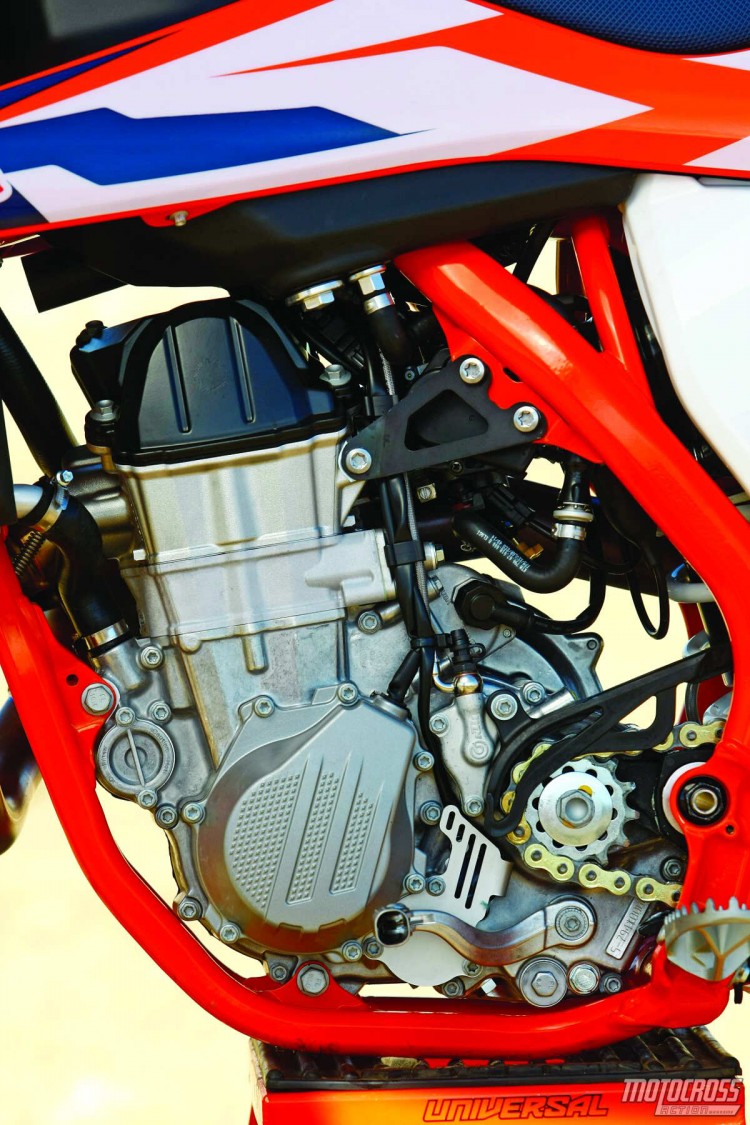
I did learn one trivial piece of information while grousing about the Torx head bolts on the sprocket, subframe and everywhere else on the KTM. It turns out that KTM did a time-management study on the amount of time it took its assembly-line workers to complete a bike with Allen bolts versus one with Torx head bolts. Because the Torx bolts do not require the workers to align the tool as precisely, the Torx bolts improved productivity by a significant degree. Thus, they aren’t changing.
• • • • •
When MXA went to the KTM factory in Austria late last summer to see the 450SXF Factory Edition IV way before anyone else ever got a glimpse of it, I knew it would be something special. They had opened their R&D checkbook and pulled out the stops to build the most advanced production motocross bike ever to grace an American motocross track. But, whenever they would ask me what I thought about all of the changes they made, I would say, “It doesn’t matter how great the rest of the bike is; all that matters is that WP doesn’t sink the ship with bad forks for the 20th year in a row.”
• • • • •
Which leads me to the performance of the next generation of WP 4CS forks. First, the good news. The forks are a major improvement over last year’s 4CS forks. The standard settings are 15 clicks out on compression and rebound. This is a good starting point for every skill level, with slower riders backing the compression out to 20 clicks while faster riders went in a few clicks. The harshness is gone and the forks don’t blow through the end of their stroke. You can race these forks as is.
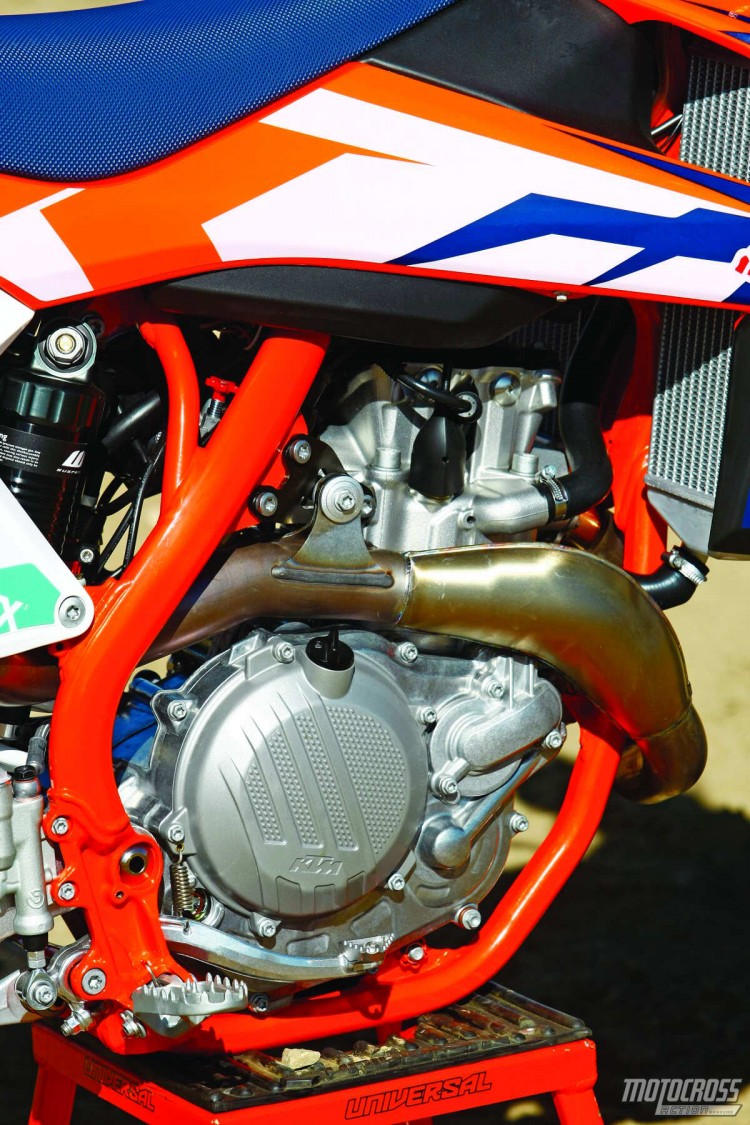
But, we do have complaints. The first half of the travel has very light damping, which makes the fork feel very quick in small and choppy stuff. Too quick! This shows up as vagueness at the front wheel. In short, it dances in the chatter and braking bumps at speed. WP’s design philosophy is to run less low-speed damping and then ramp up the second half of the stroke to stop the forks from bottoming (and bottoming control is greatly improved on the Factory Edition IV). That’s their philosophy, but it’s not ours. If we had our druthers, most MXA test riders would prefer more low-speed damping control to hold the 4CS forks higher in their stroke, which would require less high-speed damping at the end of the stroke. This would produce a more balanced feel and stop the flutter in the clutter. In our opinion, this is the biggest flaw of the new 4CS fork.
• • • • •
The new 4CS fork has clicker settings that work for 90 percent of the motocross population. The other 10 percent are riders who want their forks to be ultra soft and absorbent. MXA had test riders who raced the Factory Edition forks with the compression clicker turned all the way out with success, but there were riders who wanted the forks to be even softer. For them, we removed fork oil in 5mm increments. This satisfied the soft brigade.
• • • • •
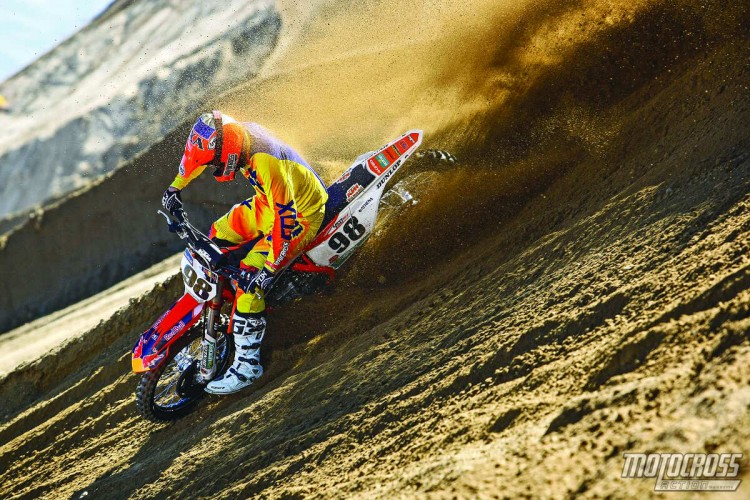
We struggled with the chassis setup on the 450SXF Factory Edition IV because the rear of the bike rode very high—disconcertingly high (and in direct contrast to the claim that the 450SXF was 10mm lower than the previous model). We originally thought that a longer link (149.7mm) would help lower the chassis and smooth out the shock action, but we couldn’t get a link made in time to help with this test. Instead, we shortened the shock to help lower the rear of the bike. We started with a 1.5mm spacer, which dropped the rear of the bike 5mm, but eventually went to a 3mm spacer to get the 10mm that KTM promised us. We liked the shorter shock. Surprisingly, the 250SXF Factory Edition did not suffer from this complaint. To reiterate, the same thing could be achieved with a 1.5mm-longer shock linkage.
Dropping the rear end not only helped the ergos, but the handling got sharper and the shock, which we felt was stagey through its stroke, became more absorbent and didn’t hit shelves of mid-stroke harshness.
• • • • •
We also had issues with WP’s choice of a rear shock spring. The stock 4.8Nm shock spring works best for riders above 190 pounds (and even then it operates with very little preload on the spring). Any rider under 180 pounds will probably have zero spring preload. This isn’t the optimum setup for a rear shock. Preload is an important tuning tool. We sent test riders of all weights out to ride with the stock 4.8 shock spring, and the heavier the rider, the better it worked. For lighter test riders, we used the 4.5Nm spring from the 250SXF. This was a great mod for riders below 160 pounds. Riders from 160 pounds to 190 pounds will need to get a 4.7 or 4.6 spring from an outside source (KTM only offers a 4.8 and a 4.5).
• • • • •
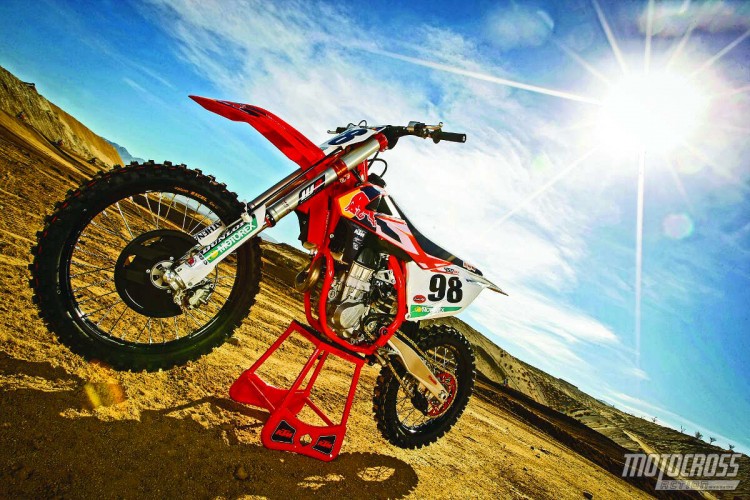
There is a trick to starting the 450SXF Factory Edition IV when it is dead cold. First, press the starter button, but not enough to start the bike. Second, listen for the fuel pump to click over. This activates the battery, and LiFeP04 (lithium iron phosphate) batteries get stronger as they get warmer. Now, reach under the throttle body and push the yellow dial up. This is the cold start button, and while most cold and hot start buttons are pulled out to engage them, the Factory Edition’s is pushed in. Now, push the starter button again. Don’t overdo it if the bike doesn’t start. Instead, reach under the throttle body with your left hand and manually push the cold start button up farther (it is spring loaded) and hold it there while hitting the starter button with your right hand. Voila. You will not need to do this trick after the first time the bike starts, but the colder the morning, the harder the bike will be to start the first time. I suspect that when the 2016 450SXF production bike arrives on the showroom floors it will have a heavier but more powerful lead-acid battery.
• • • • •
A word about gearing. The stock gearing is 13/48, which is weird because the actual gearbox is identical to this year’s regular 450SXF—and it ran a 13/50. That would lead you to believe that the Factory Edition is geared two teeth taller. Not so! KTM changed the primary gear to bring the ratios back to an approximation of 13/50. We tried adding one tooth (13/49) in an to attempt to overboost the power at lower rpm, but it wasn’t a happy experiment, so we returned to the stock 13/48 gearing because it delivered the broadest overall feel while still generating caffeinated power.
• • • • •
Nothing helps handling as much as reduced weight. The KTM 450SXF Factory Edition is 10 pounds lighter than the bike it replaces. That 10 pounds not only makes the 450SXF the lightest 450cc motocross bike sold, but it is immediately noticeable on the track. Every test rider raved about how agile the Factory Edition felt in roll (from side to side), pitch (nose high/nose low) and yaw (whipped). Losing that much weight while still keeping the electric starter is a “Mr. Watson, come here, I need you” moment. Lesser engineers would have pitched the battery, starter motor and switchgear to save weight. I, for one, am glad they didn’t take the easy route, because KTM’s electric starter is worth its weight in gold. It takes the worry out of starting your bike, especially at the starting line while waiting for your race to begin.
• • • • •
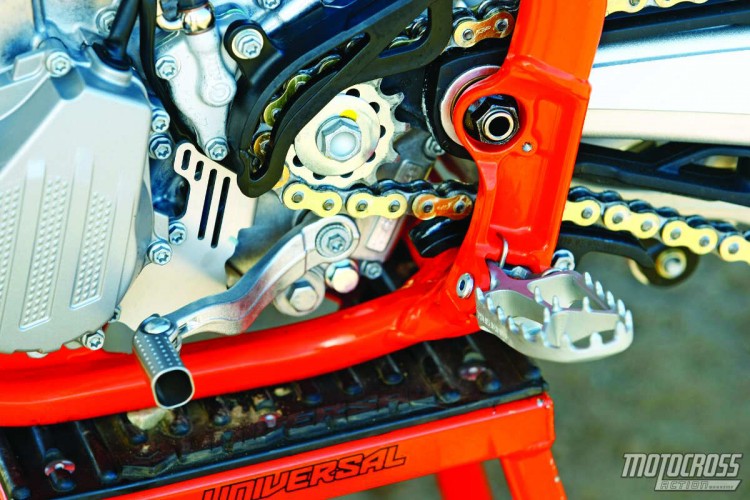
swingarm pivot, aggressive footpegs and hydraulic clutch slave unit.
“How fast is it?” I answer this question 10 times a day. It makes 57.07 horsepower at peak. That is up over last year, but the real gains are at low-to-mid and mid-to-top. That doesn’t mean that it’s weak in the middle, just that its best attributes are that it picks up stronger off idle and pulls harder over the top. Across the board it makes more horsepower almost everywhere, except from 6500 rpm to 7500 rpm, where it keeps the same output as the old engine. But, if horsepower were the measure of a machine, we’d be racing Top Fuel dragsters. The best thing about the Factory Edition engine is that it is broad, or, more accurately, broad and powerful. It delivers the right amount of power at the right time, for the optimum length of time, to be supremely usable. You never have to rush a shift to keep up with the powerband; it always has what you need. Don’t want to shift? Then rev it out; it makes 2-1/2 horsepower more at 11,000 rpm than the old engine. Want to short-shift? Go ahead; it’s got 2 foot-pounds of torque more at 5500 rpm. And, it isn’t scary fast—just plain fast. It meters the power out in usable amounts to make it easy to ride. It is a better engine in all aspects than the existing 450SXF powerplant.
• • • • •
I was never a fan of aluminum frames. Perhaps my cynicism comes from the fact that I, much like Jeremy McGrath, loved the 1993 Honda CR250 chassis. It was sharp, agile, resilient and, although a little shaky under braking, the epitome of what a motocross bike should feel like. Then, in 1994, Honda kicked the head angle out a full degree, moved the engine forward and up, lengthened the wheelbase and relocated the footpegs back 10mm and up 10mm. In the process, they killed what was brilliant about the 1993 chassis. True, the 1994 chassis didn’t head-shake under braking anymore, but it didn’t turn, either. As a motorcycle test rider, I don’t get to choose what I ride. I race what’s put on my plate. Jeremy McGrath had the luxury of superstardom, and he didn’t want to ride the 1994 CR250 frame. So, in what wasn’t a very well-guarded secret, Jeremy’s works Hondas, from 1993 to the release of the 1997 Honda Delta-Box aluminum frame, were built on 1993 CR250 frames. When the aluminum frame came to Honda, Jeremy’s favorite steel chassis couldn’t be disguised anymore. He had to go aluminum. Instead, he chose to leave Team Honda.
What does this have to do with the KTM Factory Edition IV? Lots. It’s not aluminum. It’s steel. And, steel is good. Chromoly delivers more feedback, and while MXA revealed KTM’s prototype aluminum frames in the March 2015 issue, KTM’s test riders were of the same opinion as Jeremy McGrath was 18 years ago—steel is best.
KTM’s handling is spot-on. Once you get the balance right, this bike can carve inside lines, flat-track through sweepers and make direction changes without any effort. It can almost be controlled by the rider’s knees through switchbacks. The caveat is that the front and rear must be in sync, which is why we spent so much time trying to iron out the stinkbug feel of the tall rear end (and worrying about the front-end flutter in chatter bumps). Once we flattened the chassis, this bike was on rails.
• • • • •
In all my years of writing bike tests at MXA, I’ve never before signed my name to a test. Why not? Because an MXA bike test is a collaborative effort. The final bike test isn’t the singular product of the man with the typewriter; he just blends the collective consciousness of all the MXA test riders into one final report. So, why now? The answer is simple. KTM will only produce 450 KTM 450SXF Factory Edition IVs. They are all already sold and, apart from buying a used one, you can’t walk into a dealership and roll one out. It is a limited edition. Thus, we thought that one man’s experience with the Factory Edition—mine on the 450SXF and John Basher’s on the 250SXF—would be more telling than MXA’s regular Q&A bike-test format.
• • • • •
There is so much to say about the creativity of the Factory Edition IV. It is shame that I can’t go into depth about the cool factor of KTM’s new air filter or the aerodynamically sound radiator wing design or the phenomenal clutch (that can withstand my old-school, two-stroke, overly active left hand). All that will have to wait for the 2016 KTM 450SXF. Hey, maybe they will fix the flaws that MXA complained about in this test.


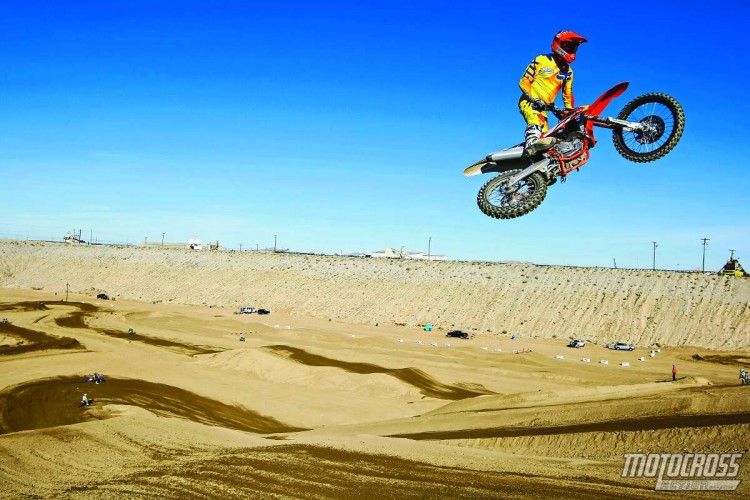



Comments are closed.